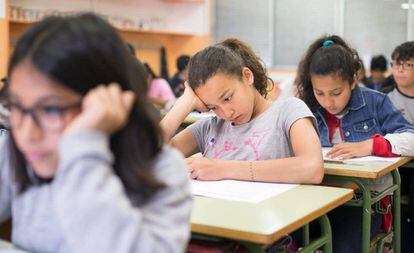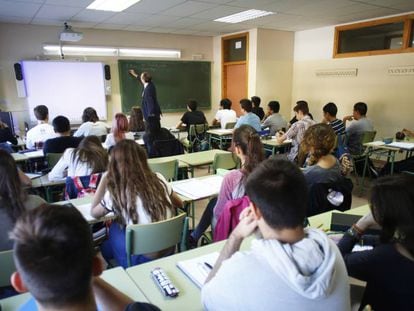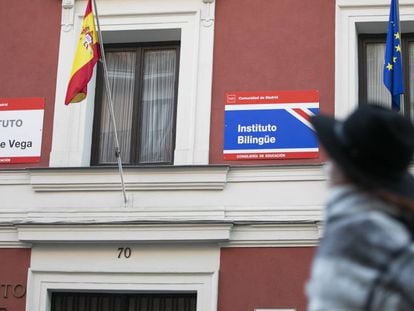Catalonia fights socioeconomic segregation at school
Authorities warn about the existence of “ghetto schools” where more than half of all students are foreign-born

Catalonia has become the first Spanish region to embark on an institutional effort to curb school segregation by socioeconomic status.
Starting the next school year, authorities will review the admission fees charged by private schools that receive public funding (known as concertados) to ensure that financial criteria are not used to select children from wealthier families.
Officials also want schools to accept an “equitable” share of students who enroll outside regular admission periods, instead of always allocating them to the same centers.
There is no choice but to move students around, even if it is not the family’s first choice
Antoni Morante, Balearics government official
In recent years, regional governments across Spain have admitted that there is a socioeconomic segregation problem in the school system, but all attempts at changing the situation have been little more than stopgap solutions.
In 2016 the Catalan ombudsman, Rafael Ribó, issued a tough report that talked about the existence of “ghetto schools” in the region. The study found that at around 100 schools – representing 4.35% of all education centers – more than half the student population was foreign-born. Together with the Balearic Islands, Catalonia is the Spanish region with the highest rate of foreign students, at 13.2%.
The Pact Against Student Segregation, signed on Monday by politicians, unions and educational leaders, contains 189 measures aimed at reducing segregation at schools. The deal also calls for the creation of an oversight committee to ensure that the guidelines are observed.
The document was backed by Junts per Catalunya (Together for Catalonia), Catalan Republican Left (ERC), the Catalan Socialist Party (PSC) and Catalunya en Comú. It was rejected by the conservative Popular Party (PP), center-right Ciudadanos (Citizens) and the small far-left group CUP.
Nearly every municipality with a population of over 10,000 also backed the effort, as did the two main labor unions CC OO and UGT, and several groups from the education community.

In recent years, Spain has been asked by the European Commission and the United Nations to address the issue of student segregation, which affects 46.8% of education centers in a country where nine out of every 10 schools are public.
A 2018 report by researchers at Madrid’s Autonomous University, entitled “Magnitude of student segregation by socioeconomic status,” found that the Balearics and Galicia show low segregation – similar to Sweden or Finland, which have the lowest rates in the EU – while it is “very high” in Madrid, on a par with Hungary and Romania.
While the causes of segregation are complex, experts agree that the root lies in the education policies developed by regional governments. “Despite existing evidence of problems with segregation, which brings down the achievement level at those centers, some regions would rather not admit that there is a problem,” says Álvaro Ferrer, co-author of the study “From socioeconomic segregation to inclusive education.”
Spain has been asked by the European Commission and the United Nations to address the issue of student segregation
The government of the Balearic Islands was a pioneer, launching a set of measures in 2015. “We are one of the regions with the highest rate of foreign students and we realized that it was necessary to get local authorities involved,” says Antoni Morante, director general of planning at the Balearics government. Regional authorities reached deals with 11 municipalities that had high segregation levels. Specialized committees made up of government members, educators and families now organize enrollment so that students with special needs and those from low-income families are evenly shared out between public and concertado schools.
“There is no choice but to move students around, even if it is not the family’s first choice,” says Morante. The system also blends higher-income and lower-income neighborhoods for a more diverse mix of students.
In the Basque Country, where 7.5% of students are foreign-born, the government released a report in November showing that most of these students are enrolled in public schools. To change this imbalance, policymakers have launched a tool to determine the rate of students with special needs at each school, which in turn means more or less public funding for that center. The move mirrors existing policies in the Netherlands, which grants more funds to centers that accept lower-income children.
English version by Susana Urra.












































